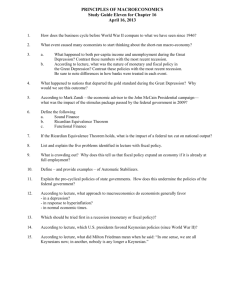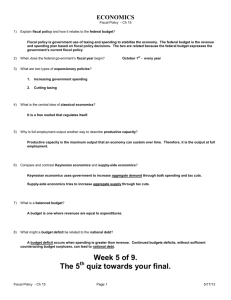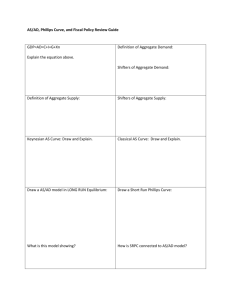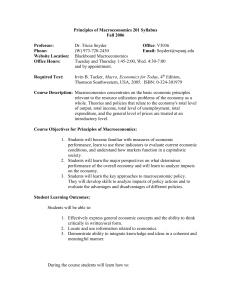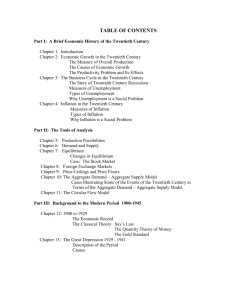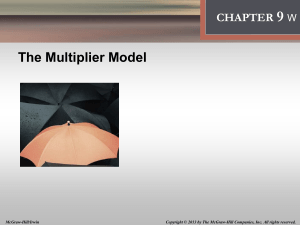Ch 11 Fiscal Policy: The Keynesian View And Historical Perspective
advertisement
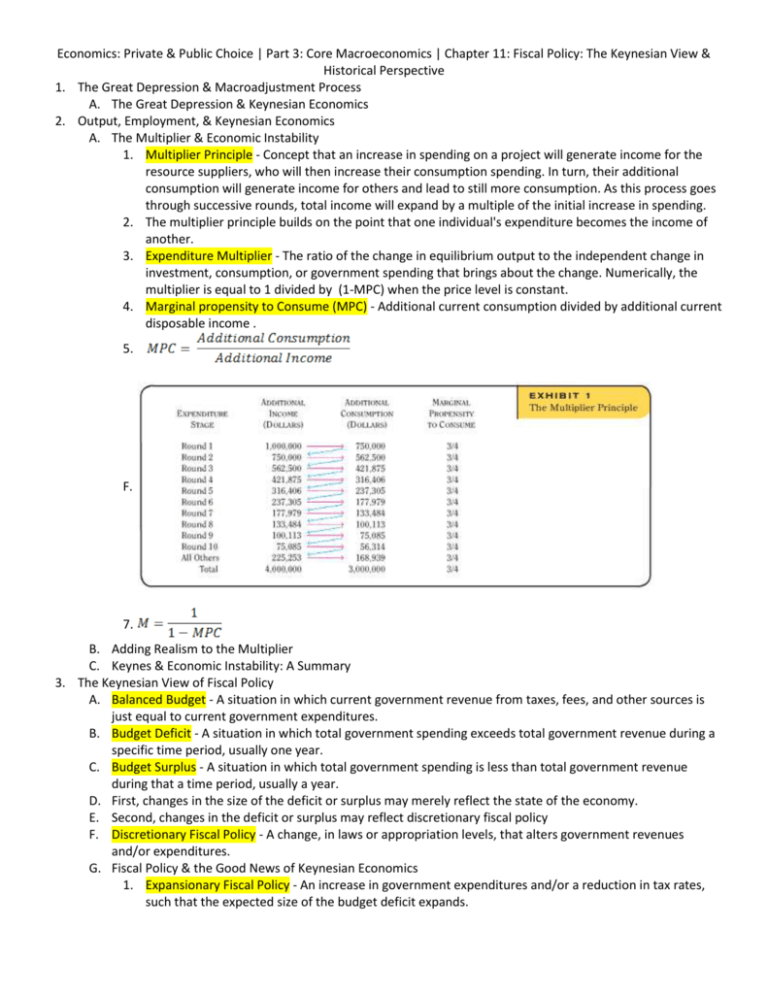
Economics: Private & Public Choice | Part 3: Core Macroeconomics | Chapter 11: Fiscal Policy: The Keynesian View & Historical Perspective 1. The Great Depression & Macroadjustment Process A. The Great Depression & Keynesian Economics 2. Output, Employment, & Keynesian Economics A. The Multiplier & Economic Instability 1. Multiplier Principle - Concept that an increase in spending on a project will generate income for the resource suppliers, who will then increase their consumption spending. In turn, their additional consumption will generate income for others and lead to still more consumption. As this process goes through successive rounds, total income will expand by a multiple of the initial increase in spending. 2. The multiplier principle builds on the point that one individual's expenditure becomes the income of another. 3. Expenditure Multiplier - The ratio of the change in equilibrium output to the independent change in investment, consumption, or government spending that brings about the change. Numerically, the multiplier is equal to 1 divided by (1-MPC) when the price level is constant. 4. Marginal propensity to Consume (MPC) - Additional current consumption divided by additional current disposable income . 5. F. 7. B. Adding Realism to the Multiplier C. Keynes & Economic Instability: A Summary 3. The Keynesian View of Fiscal Policy A. Balanced Budget - A situation in which current government revenue from taxes, fees, and other sources is just equal to current government expenditures. B. Budget Deficit - A situation in which total government spending exceeds total government revenue during a specific time period, usually one year. C. Budget Surplus - A situation in which total government spending is less than total government revenue during that a time period, usually a year. D. First, changes in the size of the deficit or surplus may merely reflect the state of the economy. E. Second, changes in the deficit or surplus may reflect discretionary fiscal policy F. Discretionary Fiscal Policy - A change, in laws or appropriation levels, that alters government revenues and/or expenditures. G. Fiscal Policy & the Good News of Keynesian Economics 1. Expansionary Fiscal Policy - An increase in government expenditures and/or a reduction in tax rates, such that the expected size of the budget deficit expands. Economics: Private & Public Choice | Part 3: Core Macroeconomics | Chapter 11: Fiscal Policy: The Keynesian View & Historical Perspective 2. 3. When an economy is operating below its potential capacity, the Keynesian prescription calls for expansionary fiscal policy - a deliberate change in expenditures and/or taxes that will increase the size of the government's budget deficit. 4. 5. Restrictive Fiscal Policy - A reduction in government expenditures and/or an increase in tax rates such that the expected size of the budget deficit declines (or the budget surplus increase) 6. Keynesians believe that a shift toward a more restrictive fiscal policy is the proper prescription with which to combat inflation generated by excessive aggregate demand. 7. Rather than balancing the budget annually, Keynesians stressed the importance of countercyclical policy, that is, policy designed to "counter" or offset fluctuations in aggregate demand. 8. Countercyclical Policy - A policy that tends to move the economy in an opposite direction from the forces of the business cycle. Such a policy would stimulate demand during the constriction phase of the business cycle and restrain demand during the expansion phase. 4. Fiscal Policy Changes and Problems of Timing A. Automatic Stabilizers 1. Automatic Stabilizers - Built-in features that tend to automatically promote a budget deficit during a recession and a budget surplus during an inflationary boom, even without a change in policy. 2. Unemployment Compensation 3. The corporate profit tax 4. The progressive income tax 5. The Keynesian Aggregate Expenditure Model Economics: Private & Public Choice | Part 3: Core Macroeconomics | Chapter 11: Fiscal Policy: The Keynesian View & Historical Perspective A. Planned Consumption Expenditures 1. Consumption Function - The relationship between disposable income and consumption. When disposable income increases, current consumption expenditures rise, but by less than the increase in income. 2. B. Planned Investment Expenditures 1. Autonomous Expenditures - Expenditures that do not vary with the level of income. They are determined by factors such as business expectations and economic policy. C. Planned Government Expenditures D. Planned Net Exports 1. E. Planned versus Actual Expenditures F. Keynesian Equilibrium in the AE Model 1. Equilibrium is present in the Keynesian AE model when planned aggregate expenditures equal the value of actual output. 2. Equation: C. G. Equilibrium at Less Than Full Employment Economics: Private & Public Choice | Part 3: Core Macroeconomics | Chapter 11: Fiscal Policy: The Keynesian View & Historical Perspective 1. If an economy is in Keynesian equilibrium ,there will be no tendency for output to change--even if output is well below full-employment capacity. H. Keynesian Equilibrium--A graphic Presentation 1. B. I. How Can Full Employment Be Achieved? Economics: Private & Public Choice | Part 3: Core Macroeconomics | Chapter 11: Fiscal Policy: The Keynesian View & Historical Perspective 1. J. 2. Keynesians argue that control of aggregate expenditures is the crux of sound macroeconomic policy. If we could ensure that aggregate expenditures were large enough to achieve capacity output, but not so large as to result in inflation, then maximum output, full employment, and price stability could be attained. The Aggregate Expenditure and the AD-AS Models 1. 2. Under conditions like those of the 1930s--when idle factories and widespread unemployment were present--increases in aggregate demand will exert a strong impact on output. In contrast, however, when an economy is already operating at or near full-employment capacity, additional aggregate demand (for example, the shift to AD3) will predictably exert its primary impact on prices rather than output.
